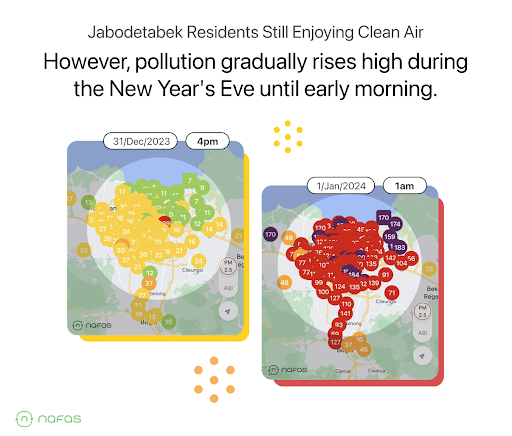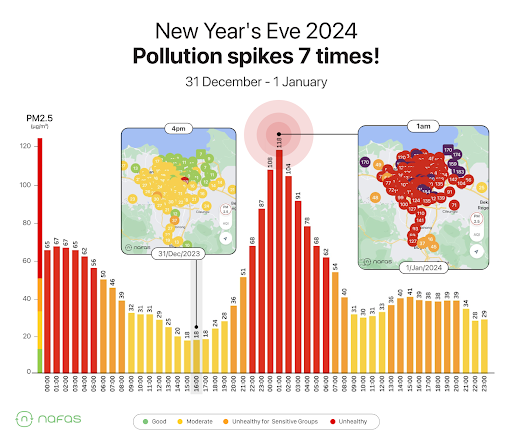New Year, Same Old Problem: Pollution Surges Sevenfold
The city center is packed with reciprocal laughter echoing at every corner. Thousands gather in the same place to welcome 2024. The highly anticipated highlight is the midnight fireworks dance in the sky. However, it turns out to have a significant impact on the air quality in the area.
Is the simultaneous fireworks display in many areas of Jabodetabek indeed a source of high pollution on New Year's Eve? Let's delve further through the presentation of data from the Nafas sensors.
Healthy in the Evening, High Pollution at Midnight
The air quality in the Jabodetabek region on the last evening of 2023 is quite good. Many areas in Jakarta enjoy fresh air after rainfall, indicated by the Nafas sensors showing the color green. As seen on the Nafas sensor map on December 31 at 4 p.m. below.

However, this situation didn't last long. Air quality significantly deteriorated, as seen on the Nafas sensor network in Jabodetabek on January 1st, 2024, at 01:00 AM.
Fluctuating Pollution Levels on New Year's Eve
On the last day of December 2023, Jabodetabek was shrouded in high pollution from midnight until 05:00 AM WIB. However, the pollution gradually decreased due to atmospheric dynamics and rainfall.
The air quality was in good condition and monitored as healthy with PM2.5 at 18 µg/m3 from 03:00 PM to 05:00 PM WIB. However, this condition didn't last long as air pollution consistently increased in the evening starting from 10:00 PM WIB.

![]()
During the New Year's Eve transition, when hundreds, even thousands of fireworks illuminate the sky in Jabodetabek, the average pollution levels soar to 108 µg/m3. The peak pollution is recorded at 118 µg/m3 at 01:00 AM WIB. Pollution levels in some areas of Jabodetabek range from 159-184 µg/m3, categorizing the air quality as Very Unhealthy!
Many sources contribute to the high pollution on New Year's Eve, one of which is fireworks. The smoke from fireworks explosions releases various pollutants such as SOx, NOx, CO2, and CO (Singh, et al., 2019), detected as high pollution. Additionally, atmospheric conditions that trap pollutants also contribute to the elevated pollution on that day.
Behind the vibrant colors of fireworks in the sky, lurks air pollution always ready to manifest its consequences. Although clean air is yet to be prevalent in the early days of this year, there is still time to strive towards cleaner air for everyone.
Happy New Year 2024!